Newhall Refinery

Newhall Refinery in 1959 (from the SCV Historical Society)
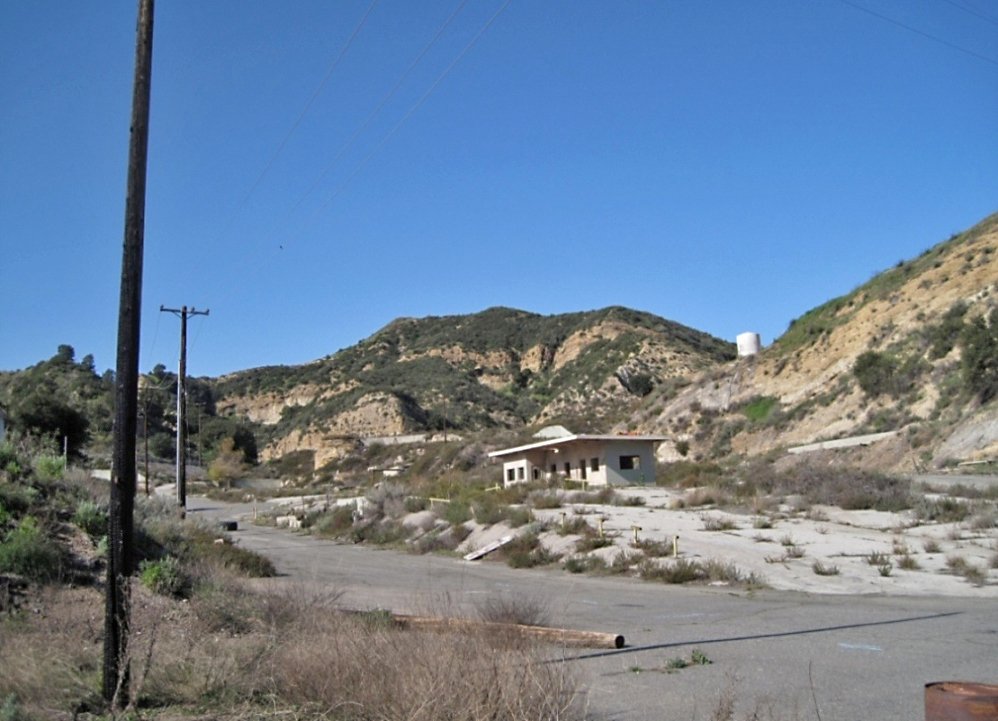
About the same view on 2/13/2010
Here is some of the history of the Newhall Refinery listed by year. It has gone through three name changes. From 1930-1933 it was the Andrews Refinery. From 1933 to 1942 it was the San Fernando Refinery. From 1942 until its total shutdown in 1990 it was the Newhall Refinery. There were many fires and injuries at the refinery during its lifetime. There were also at least three deaths - James Breckenridge in 1944, William C. Crockett in 1961, and Howard M. Brock in 1966.
Warning: the refinery, including Beale's Cut, is on private property. Even as late as 1988, the refinery was fined for excessive sulfur dioxide emissions so there are probably still hazardous waste there.
1928:
The Newhall Signal of May 3, 1928, reported that a small refinery was being built on the Crawford lease. The Crawford lease was north of the Newhall Tunnel on land that included the future Newhall Refinery. The new refinery was being built for production of up to 100 barrels per day. The next article about this refinery was not until July 24, 1930, in the Signal. At that time, it was reported that the employees of the Newhall Oil and Refining Company wanted their wages for the construction and removal of the refinery, which occured a couple of years ago. Men named Black and McCoy were involved. The employees complained to the State Labor Commission but no results of the complaint were reported. Three wells had already been drilled (by the Crawford Syndicate Oil Co.) on the Crawford lease between 1922 and 1924. By 1927, two men named Anderson and McCoy had a contract to operate those three wells and to drill additional wells. They drilled one well, which was completed in early 1928. At this time, they probably decided that a refinery was needed and started construction. However, very little oil was found in the fourth well (about 5 barrels per day), so they probably decided to give up on the refinery and had it torn down. The Newhall Oil and Refining Company was incorporated on April 1, 1930, with P.B. Anderson as president. Maybe at that time the employees thought that they had a chance to get their lost wages from a legally formed company, since they evidently couldn't get them from the individuals involved.
1930:
An article in the Newhall Signal of January 23, 1930, stated the need for for refining non-Standard Oil crude near the new wells being drilled in the area. A refinery was needed.
On April 20th, 1930, the Long Beach Press Telegram reported that the William B. Andrews Oil Company was granted a permit to erect a refinery with storage tanks near the Newhall Tunnel. Soon after that, construction began. William Andrews, an Oklahoma oil man, was the president of the company. One of the officers of the company was future owner Joseph O. Moffett. The monetary investment was about $100,000. The capacity would be about 3500 barrels of oil per day (The Oil City Derrick, Oil City, Penn., July 10, 1930), although an earlier article said 2000 barrels. Gasoline, kerosene, gas oil, lubricating oil, and road oil would be produced. Crude oil for the refinery would come from the independent oil well operators on Needham Ranch leases (the future Tunnel Area Oil Field). Crude would also come from wells in Ventura County such as Sulfer Mountain and Piru.
Nearing completion, this July tenth 1930 Oil and Gas Journal (Vol. 29, No. 8, p.151) article with photo says the capacity would be 2500 barrels. The refinery began operations in July of 1930. To run the refinery, Andrews started the Andrews Refining Company and the refinery was commonly called the Andrews Refinery, although newspapers also called it the Newhall Refinery. Aerial photos from 1930 show the refinery.
1931-1933:
Andrews Refinery news.
1933:
Sometime during 1933, probably between April (the last article mentioning the Andrews Refinery was in April) and June, Andrews sold the refinery to company officer Joseph O. Moffett (1890-1964). Moffett then renamed the Andrews Refining Company to the San Fernando Refining Company (Newhall Signal, June 21, 1945 and Newhall Signal, July 16, 1959). The refinery was usually called the San Fernando Refinery. In the 1940's, Moffett would become the mayor of San Fernando. The Report of the California State Board of Equalization for the Fiscal Year ending June 30, 1933, shows the San Fernando Refining Co. (under Moffett, J.O.). It did not exist on any report before this.
1938:
In the "California Oil World Directory", J.O. Moffett is listed as the proprietor of the San Fernando Refining Company (PO Box 310 San Fernando, Ca). William D. Parks was the general superintendent and E. Ericson was the purchasing agent. The company had a refinery near Newhall with an annual refinery output 3,500,000 gallons.
1939:
In the International Pertroleum Register of 1939 it is stated for the San Fernando Refining Co: "Personnel: J.O. Moffett, Gen. Mgr.; L. Goddard, Sales Mgr. (service stations); E. Ericson Pur. Agt. Marketers: Serves 69 service stations in Calif. only; 5 owned trucks, 8 leased. Fuel oil dealer."
1942:
On December 1, 1942, the ownership of the Newhall refinery was taken over by employees William Parks and E.A. Ericson (Newhall Signal, 11/27/1942). They formed a partnership they called the Newhall Refining Company. Ownership records state that the owners were William Delaney Parks (1903-1963), Ivalle Parks (his wife, 1900-1991), Edward Arthur Ericson (1895-1979), and Vena Ericson (or La Vena, his wife, 1896-1988). According to a Daily News article (8/29/1989), Parks used his and his wife's life savings. The refinery could process 3,500 barrels a day at full capacity. The refinery became known as the Newhall Refinery. In July of 1954, they incorporated with each man (or family) holding 120 shares of stock. The new company's address was:
Newhall Refining Co Inc
22674 N Clampitt Rd
Newhall, CA 91321
tel: 805-259-2660
1944:
On August 12, 1944, a major fire occured at the Newhall refinery. A laboratory flame ignited fumes from a burst naphtha line and in seconds a 10,000 gallon tank of naphtha blew up. Flames shot up nearly 2000 feet into the sky and storage tanks exploded. James Breckenridge died in the hospital from burns suffered in the first explosion and William Taylor was seriously burned while dragging Breckenridge from the flames. Flames and heat from the burning tank ignited others, and one by one, tanks began blowing up. At one time, 18 of the 25 tanks were burning. See the Los Angeles Times story from August 13, 1944, here and a story from the San Fernando Valley Times of August 17, 1944, here. Read another story from the Newhall Signal August 18, 1944, here. Also, see here for a British Pathe video that shows the fire. (Downloaded from the Santa Clarita Valley Historical Society website and used by permission.) By 1945, the refinery was producing again.
1952:
Small fire at the refinery reported by Newhall Signal of September 4, 1952.
1955-56:
Segment of video (Rio Santa Clara, Myna Lou Productions, 1956) showing the refinery in 1955 or 56. Used by permission of the Santa Clarita Valley Historical Society, where the full video can be viewed.
1959:
In February, 1959, all the shares of the Newhall Refining Company were bought by oil tycoon Edwin Pauley. The Newhall Refining Co. became a subsidiary of the Pauley Petroleum Company. Parks remained as president and general manager while Ericson retired. As part of the deal, Parks retained ownership of all the oil wells owned by the company. Pauley Petroleum was founded in 1958 by Edwin W. Pauley. See the Newhall Signal of July 16, 1959 and the California Oil World (Vol. 52 No. 11, p.16) from June of 1959.
1961:
On May 18, 1961, there was a fire at the refinery. (From the Newhall Signal.)
On June 24, 1961, William C. Crockett, 60, a workman was killed when he fell 25 feet from a condenser platform at the refinery. He had climbed up a ladder to tighten some bolts when he slipped and fell. (From the Newhall Signal of June 29, 1961.)
1963:
L. J. Campbell, 47, was appointed president of Newhall Refining Co. succeeded William D. Parks. Parks will remain as board chairman. (From the Los Angeles Times, 2/27/1963.)
On April 25, 1963, the Newhall Signal reported another fire at the refinery.
1964:
A welder's spark touched off a fast moving fire that threatened Newhall Refinery Co. property south of Newhall was contained in less than an hour by Los Angeles County and U.S. Forest Service fire fighting units shortly after 1 p.m. yesterday. The fire erupted in a sump area where refuse and oil was dumped. Vapors in oil lines caught fire and raced for lower ground to reach the sump. Flames also spread to a 150-barrel oil tank and scorched another 200-barrel tank. Fireman were able to control the blaze before it spread to more than a dozen oil tanks located on a hill nearby. Damage was estimated at approximately $1000 to tanks and refinery equipment. (Van Nuys Daily News, December 8, 1964.)
1965:
The first phase of an expansion program was completed at the refinery. See the Newhall Signal of June 10, 1965.
1966:
Howard M. Brock of Chatsworth died of burns he received when jet fuel spilled on his clothing and ignited. Brock was a maintenance supervisor working on a pipeline connection when a leak soaked some of his clothing with fuel. The fuel was then ignited by a nearby heater. Brock had been an employee for 21 years. (From the Los Angeles Times of May 3, 1966).
1969:
The Newhall Signal of June 20, 1969, reported an explosion at the refinery.
1970:
The Newhall Refining Company, a subsidiary of Pauley Petroleum, was sued by scores of insurance companies for homeowners. It was claimed that they "negligently and in violation of the law set fire to, allowed fire to be set to and allowed such fire and permitted fire burning upon property owned and controlled by defendants to escapt to property of others without using or exercising due or any diligence to control such fire." From the Los Angeles Times of December 27, 1970.
1971:
The refinery was forced to shut down temporarily due to damage from the 2/9/1971 Sylmar earthquake. There was damage to storage tanks and pipelines. At that time, the refinery was a 5500 barrel per day plant producing asphalt, road oils, and jet fuels. When the quake occurred, two men on a tower were bruised, but not seriously injured. The bottom of one jet-fuel storage tank buckled, and there were scattered leaks elsewhere at the refinery. The main problem was a lack of water. Both sides of a pump on the water line leading to the refinery were ruptured. There was also some minor damage to testing equipment in the laboratory. The refinery had about 400,000 barrels of tank storage. Three 20,000 barrel tanks, 60 feet in diameter by 40 feet high were full of jet fuel and had buckling on one side. Two 120 foot in diameter by 40 feet high tanks had no damage. (See here for damage information.)
On September 27, 1971, flames were reported at the refinery but quickly put out. (Los Angeles Times of September 28, 1971.)
1972:
The Newhall Signal of October 11, 1972, reported a fire at the refinery.
1974:
A proposed zone change to allow for the expansion and modernization of the existing refinery was sent back to the Regional Planning Commission for an environmental impact report and a review by the Air Pollution Control District. Two bus loads of Santa Clarita residents made the trip downtown to fight the zoning change. Company officials said that the project would actually result in the decrease in annoying odors and that the refinery's capacity will not be increased but will allow it to product a greater variety of fuels. (Valley News March 15, 1974.)
The Refinery zoning change request delayed.(Van Nuys News, August 1, 1974.)
Change of zoning request is an ecological dilemma. (Los Angeles Times, August 15, 1974.)
The Newhall Refining Co. is not paying fire taxes.(Newhall Signal, August 16, 1974.)
1975:
The zoning changed requested by the Newhall Refining Co. was approved. (Newhall Signal, April 23, 1975.)
Newhall oil refinery worker Walter Fritchner, 43, was burned Tuesday when he was sprayed with hot oil. He was listed in fair condition at the Sherman Oaks Community Hopital Alisa Ann Ruch Burn Foundation with second-degree burns over 20% of his body. Fitchner was cutting a pipe to a crude oil heater when vibration caused a valve to open spraying his legs and thighs with hot oil. (From the Van Nuys News of October 30, 1975.)
A $1.7 million settlement was accepted by 35 insurance companies seeking recovery from Newhall Refining Co. and Pauley Refining Co. of home damage claims paid out in the 1970 Chatsworth-Newhall fire. The 35 insurance companies had initially sought $4.5 million from the two refineries on the grounds the fire was started by faulty wiring in the Newhall refinery. (Santa Ana Register,
December 5, 1975.)
1976:
The Newhall Signal of July 9, 1976, reported a fire at the refinery.
Pauley Petroleum reported that net income for the third quarter and nine month periods ending May 31 more than doubled that reported from comparable periods last year. President William Pagen said that a substantial increase in throughput at the Newhall refinery was the major factor in the strong sales figures posted by the company. (Star-News, Pasadena, CA., July 25, 1976.)
1977:
The Newhall Signal of May 20, 1977, reported a "smoker" at the refinery.
Anniversary of the huge 1970 fire reported in the Newhall Signal of September 28, 1977. This fire started at the Newhall refinery spreading all the way to the ocean in Malibu killing 4 people.
1978:
"A second stage of modernisation of the Newhall Refinery is budgeted at $20mn, and should be completed in 1979, primarily to upgrade refinery products. First phase of modernisation was completed in 1977 at a cost of $10mn." (Oil and Gas International Year Book, Financial Times, 1978)
1979:
"Willam R. Pagen, president of Pauley Petroleum, Inc. announced recently that $5,000,000 in bonds have been issued by the California Pollution Control Financing Authority for construction of pollution control facilities at the company's refinery in Newhall, California. The bonds, issued November 30, 1978, bear an average interest rate of 6.071 percent." (California Business, volume 14, 1979)
1981:
A refinery truck driver was in critical condition Saturday from burns received during a pumping accident. The refinery driver, Jesse Sutton, was at the Sherman Oaks Community Hospital burn center with third-degree burns over 75 percent of his body. Sutton was injured Friday night at the Newhall Refinery while pumping a sulfur-hydrogen liquid from a collection tank into his truck. Sutton told firemen the fuel overflowed and flashed when it hit hot metal. His vacuum truck was destroyed at an estimated loss of $55,000. The refinery sustained no damage. (Van Nuys News, August 16, 1981.)
1984:
Pauley Petroleum announced that its Newhall refinery is on the auction block again and that preliminary negotiations are under way. About 1 1/2 years ago, the company was close to selling the independent refinery, but the deal fell through. Pauley declined to identify the new prospective buyer except to say it was a private investor, not another oil firm. The refinery produced 5.2 million barrels of petroleum products last year and generated most of the company's 1983 revenues. (Orange County Register, Santa Ana, Ca, September 5, 1984.)
1985:
Investment group bids for Pauley Petroleum. (Los Angeles Times, May 30, 1985.)
Pauly Petroleum rejected two buy-out offers. (Los Angeles Times, August 10, 1985.)
The refinery had a capacity of 23,000 barrels of oil a day. Three firms were issued violation notices by the South Coast Air Quality Management District for excessive sulfur content in their fuel oil. They said that the oil was purchased from the Newhall Refinery. Refinery senior vice president for manufacturing Hans Mangold said that all fuel oil is tested for sulfur content. He thinks that the oil was tainted by either residues in a fuel truck or from some other source. The three firms were fined.(Los Angeles Times, October 13, 1985.)
The North Valley (Sunshine) Landfill was providing more than 1 million feet of landfill gas daily to the Newhall Refinery for use as a boiler fuel via a 6 inch line from a recovery plant at the landfill since 1982. This was ended in 1985. The pipe was originally owned by the Mobil Oil Corporation and later bought by Getty Oil (name later changed to Getty Synthetic Fuels, Inc) in 1981. In 2008, the last segment of the pipe (711 feet) under Sierra Highway was filled in with concrete in some sections and abandoned in place in other sections.
1986:
On August 29, 1986, the Los Angeles Times reported that South Coast Air Quality Management officials has issued the Newhall Refining Co. oil processing plant its 12th violation notice since April. This notice was for emitting annoying odors. Most of the other citations issued since April accused it of emitting too much sulfur dioxide (a lung irritating gas that contributes to acid rain) and with running boilers and heaters with fuel containing too much hydrogen sulfide. Each of the 12 pending violation notices are punishable by a penalty of up to $1,000. The company recognized that more violations are likely because of recent malfunctions involving a $100,000 sulfur-recovery unit the company installed in 1985 to supplement an older sulfur-control system. The company has asked the district for protection from additional citations through next March, by which time it hopes to have the equipment working properly.
On September 11, 1986, the Los Angeles Times reported that the South Coast Air Quality Management District voted unanimously to grant the refinery a variance allowing it to continue operating until the November deadline without facing fines for new violations stemming from the illegal release of sulfur dioxide. The ruling resulted from complaints by the Placerita Canyon Property Owners Association. A plant closure would cost the Newhall Refinery Co. about $30,000 a day by preventing the company from fulfilling its contracts with public agencies and private firms.
1987:
On July 30, 1987, the Los Angeles Times reported that Hondo Oil & Gas Co., a New Mexico company, has agreed to merge with Los Angeles based Pauley Petroleum Co. The merger would be carried out by Pauley, which would issue 10 million new shares to Hondo, giving it slightly more than 77 % of the combined operation. The new company would probably retain the Pauley name. Most of Pauley's business comes from its 22,000 barrel-a-day refinery in Newhall. Pauley had sought unsuccessfully three years ago to sell the Newhall refinery. This merger transaction would not be completed until January of 1988.
1988:
On Sunday January 17, 1988, at about 1 a.m., a single-engine Cessna 182L plane flying through a driving rainstorm crashed into the mountain next to the Newhall refinery narrowly missing storage tanks. All four people aboard were killed. The victims were all longtime members of the Los Angeles County Sheriff's Department. The pilot was identified as Lt. Harry Parson, 50, a 27-year veteran of the department. He was traveling with his wife, Deputy Therese Pinocchio, 38, a 13-year veteran of the department. The couple lived in Long Beach. Also killed were Capt. George E. Reed, 43, commander of the Men's Central Jail, and his wife, Deputy Rosemarie Reed, 47, of Glendale. (From the Los Angeles Times of January 18, 1988, and the Los Angeles Times of January 19, 1988.
Pauley Petroleum Inc. acquired the Hondo Company with a stock exchange transaction. Pauley issued 10 million new shares of common stock in exchange for all of the common stock of Hondo. (Roswell Daily Record, January 30, 1988.)
The Los Angeles Times of January 30, 1988, reported that the Newhall Refining Company was fined $11,250 for excessive sulfur dioxide emissions in December.
1989:
"The Newhall Refinery is a modern oil refinery in Newhall, California with a capacity of 20,100 barrels per stream day. It is a hydroskimming operation with the ability to produce diesel and light oils, asphalt, jet fuels, gasoline, fuel oil and certain other products. In addition, it has a medium pressure bydrotreater which provides the ability to remove sulfur from diesel fuel and gas oil." (Moody's Industrial Manual, volume 2, 1989)
"As many as 85 employees of the Newhall Refining Co. could face layoffs or reassignment if the plant's parent company goes through with plans to sell a sister refinery, according to Newhall's top executive. Newhall President Al Siegnr said Pauley Petroleum Co.'s decision to try to sell the Fletcher Oil and Refining Co. in Carson could spell the end for Newhall's asphalt production, but will not shut down the refinery. Pauley purchased Fletcher last March and spent more than $15 million to upgrade the facility's asphalt capacity so that production could be transferred to Carson. Siegner said that if Fletcher is sold, the buyer would likely insist that Newhall get out of the asphalt market. Asphalt makes up about 40 percent of Newhall's production, Siegner said. He conceded that layoffs could be forthcoming if the company does not diversify into other aspects of oil production. Operations at the Newhall refinery, which has the capacity to process 21,000 barrels of crude oil a day, are being phased out and production shifted to the Carson refinery, he said." (Los Angeles Daily News, January 9, 1989)
"Newhall's only oil refinery is for sale for an undisclosed price, company executives said Tuesday, and city officials estimated the sale could cost the community more than 85 jobs. Negotiations are under way with several potential buyers interested in Newhall Refining Co., which processes primarily jet fuel along with other petroleum products from its refinery in the mountains along Sierra Highway. The refinery is owned by the Los Angeles based Pauley Petroleum Co. " (Los Angeles Daily News, September 6, 1989)
Pauley Petroleum is closing the Newhall Refinery by the end of the year. (Los Angeles Times, October 17, 1989).
The board of directors of Pauley Petroleum have approved a name change to Hondo Oil & Gas Co. to be effective January 1, 1990 (Roswell Daily Record, October 20, 1989).
Newhall Refining Co., a wholly owned subsidiary of Pauley Petroleum, notified employees that it anticipates the suspension of operations at the refinery before the end of the year (Roswell Daily Record, October 20, 1989).
On December 15, 1989, Hondo permanently suspended all operations at the Newhall Refinery because of continuing operating losses and reclassified the cost of the property to its real estate segment. Upgrades required by environmental laws would be too costly to perform. 15 of its 86 employees will be offered jobs at Pauley's other refining unit, Fletcher Oil & Refining Co. in Carson. The rest will be laid off. The refinery has suffered losses in recent years, and future demand for the refinery's products--mostly liquid asphalt, fuel oil and jet fuel--appear "unlikely to reach sufficient levels to justify a resumption of operations in the near future," Newhall Refining said. (From SEC filings filed by the Hondo Company by Robert O. Anderson, Chairman of the Board Pauley Petroleum Inc., April 14, 1994.)
The December 1989 issue of the National Petroleum News (Vol. 81 Iss. 12 p.18) reported the closure of the Newhall Refinery.
1990:
"The Newhall Refinery, a landmark in Newhall for more than 60 years, will be torn down and its 107-acre site along Sierra Highway sold." "Hondo Oil is the parent company of Newhall Refining Co., which shut down in December after several years of financial losses. About 70 workers were laid off. The refinery's principal products were asphalt, fuel oil, and jet fuel. Officials with Hondo Oil, known until recently as Pauley Petroleum, have applied for a demolition permit from the city of Santa Clarita." (The Los Angeles Times, March 22, 1990.)
1991:
A Valley Gateway development plan for the Newhall Refinery property was adapted by Hondo. The plan included dismantling the refinery, doing the required environmental remediation of the land, and developing the land to a condition where it could be sold.
The Newhall Refining Co. declared Chapter 7 bankruptcy. (Los Angeles Business Journal, August 12, 1991)
1992:
Hondo seeks permission to build an apartment complex and business park on the refinery site. (Los Angeles Times, July 8, 1992.)
1993:
Valley Gateway project wins backing from City of Santa Clarita Planning Commission. (The Los Angeles Times, May 23, 1993.)
The Hondo Gas & Oil Co suspended execution of the Valley Gateway development plan for the Newhall Refinery property in September. The decision was made as a result of declines in the local real estate market and the company's limited cash resources. Hondo then to sell the property in its present condition. Hondo did conduct an environmental assessment of the refinery site and a remediation plan for the site was submitted to the California Regional Water Quality Control Board and received staff approval. They requested bids from contractors to remove contaminated soil from approximately 35 acres of the 105 acre site. Hondo expected that the remediation plan would cost $2.0 million. (From Hondo Oil & Gas, Notes to Consolidated Financial Statements, September 30, 1996, Note 12 Discontinued Operations)
1999:
Hondo sold 117 acres, including the Newhall Refinery and Beale's Cut to Landbank, a remediation company based in Lakewood, Colorado, for $200,000. Landbank had plans to clean up the refinery waste and make the land salable for a business park. (Newhall Signal, February 17, 2000)
2006:
Refinery site considered as a possible site for a minor league expansion baseball team. (Los Angeles Times, March 28, 2006.)
2010
As of March of 2010, Forum Engineering and Construction owns much of the land in the Tunnel area probably including the refinery property. They had a lobbyist working for them as late as 2009 on a project at the refinery (which they called the Hondo Oil Refinery) called Sierra Gateway, probably a project similar to the old Valley Gateway project of Hondo. (From the 2009 Santa Clarita Lobbyist Report)
2010
The refinery property is one of the last three sites recommended for a recycling plant. The plant is the the city, but never built. See Newhall Signal articles from November 17, 2010, and from November 24, 2010.
2013
"Three men were arrested Saturday afternoon after allegedly stealing more than $950 work of metal from an old refinery in Newhall." Newhall Signal, April 14, 2013.
The major problem for the owner is the clean up of the refinery site. Who's going to do it and how much will it cost? However, once that is done, any development project would have to take into account Beale's Cut and the SR-14 Los Pinetos undercrossing. As a significant historical site, the cut area would probably have to be donated to the government - most likely the City of Santa Clarita. Then there would need to be an open area as an animal corridor between Sierra Highway and the Los Pinetos undercrossing. It would have to be wide enough to satisfy many different conservation groups, not an easy task. It is now 2021. The site has been cleaned up a little, but is still a mess. No solution seems to be on the horizon.
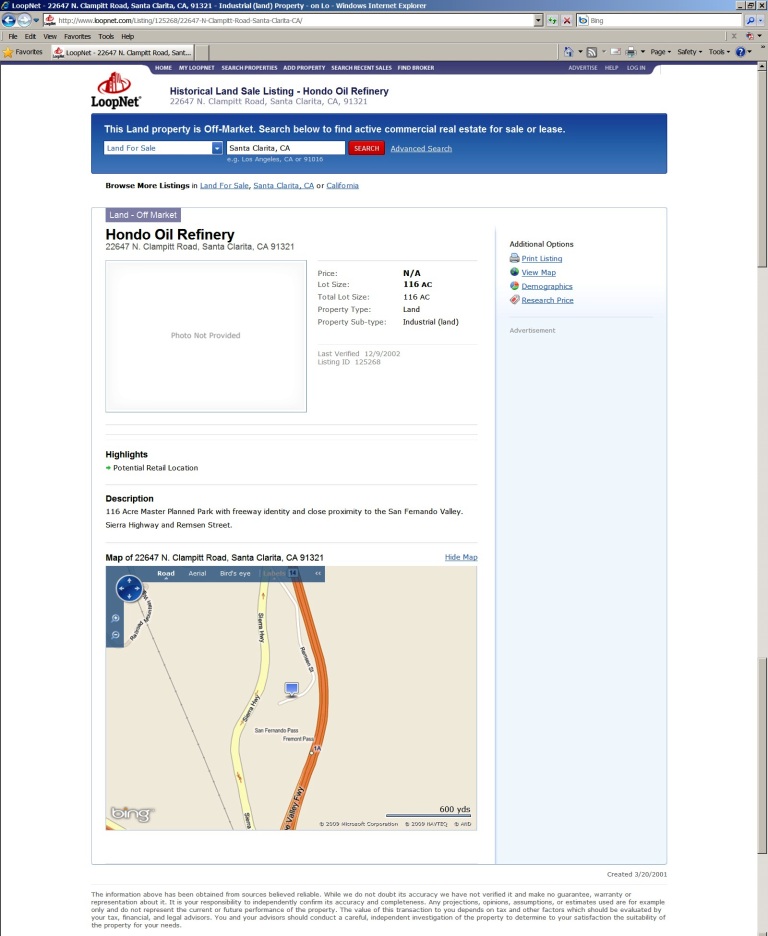
The Hondo Oil Refinery was once for sale on LoopNet in 2001 and 2002
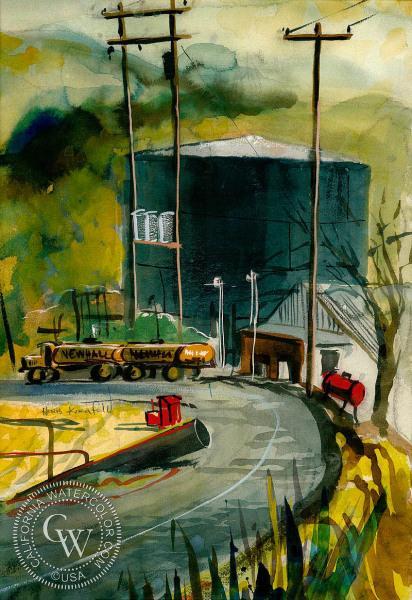
Watercolor of the Newhall Refinery by Herbert L. Kornfeld
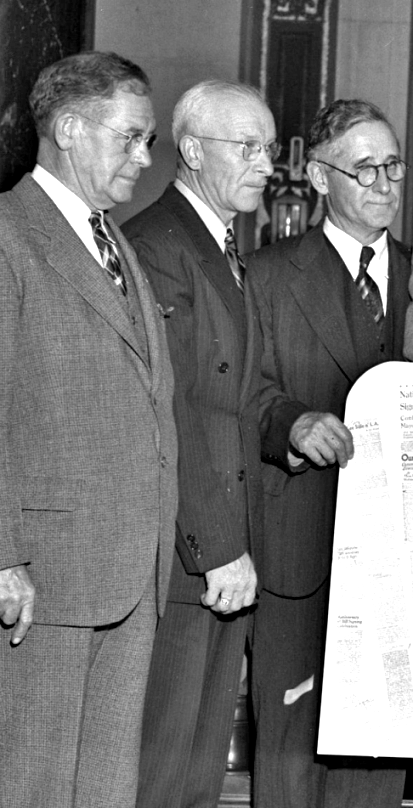
Photo taken on November 8, 1941. The man in the middle is Joseph O. Moffett, mayor of San Fernando at that time and owner of the San Fernando Refining Company from 1933 - 1942.
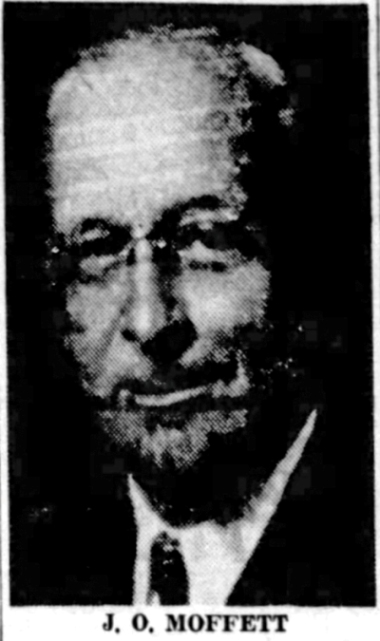
Poor photo from the San Fernando Valley Times of May 16, 1940.
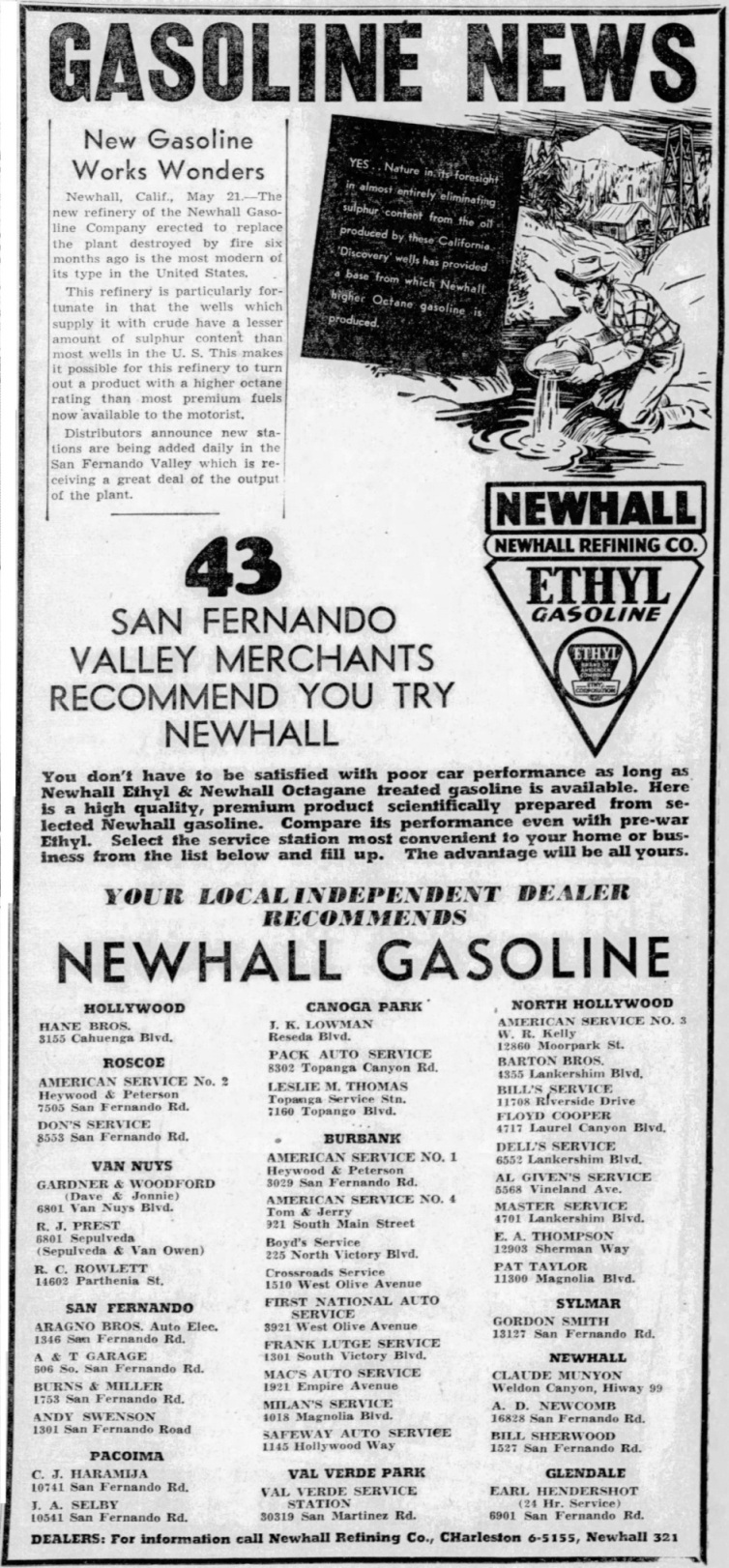
Ad from the San Fernando Valley Times after the refinery was rebuilt after the major 1944 fire.







